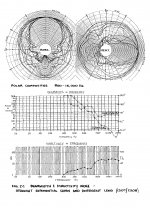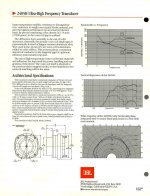This is a large horn. 🙂 To make the model size reasonable the mesh resolution has been reduced and the model is only good to about 5Khz or so.
It loads quite low and has a nice bias for the horizontal plane. Minor horizontal polar roughness is from the roundover mesh resolution. The vertical would need a larger roundover it more off-axis smoothness were needed.
Add - just noticed the horn name was wrong is the original graph title - fixed now.
I dunno you guys! What do you think? Go big or go home? I could use a 40" wide horn (~31" deep)...If we can make the lip how you think it should be, for actual printing....why not lol
Last edited:
Loudspeaker Qtc by John Kreskovsky, using different sine wave type inputs and complex wave inputs. 2 pages > use the arrow.
Why the minimum? Group delay? As you said yourself, it's all in the HP filter, so if I EQ the responses to be the same between a .75x fc and a 1.5x fc, then the group delay will be the same. As I said, its a linear system so almost everything is possible. It's the impositions imposed by nonlinear limiting constraints that pose the problem (like excursion, etc.). As long as that doesn't happen, EQ away.
Many thanks for this explanation.
I'm totally agree with that because it's what I've found in the past...It's better when you explain (credibility 😀 )
Very very interesting point (should need a new thread)
Last edited:
To me this would likely be excursion related. It would be tough to accurately determine what the problem was.
To me horns and waveguides are linear systems and behave that way until very very high SPL. If something goes haywire, I'd look to the driver, first, if the problem is nonlinear (i.e. always sounds bad.) If its linear then the horn could have internal resonances or diffraction that you are hearing, but these too are linear (diffraction perception of course is not linear.) But, as I said above, the resonances do sound bad.
To repeat for the umpteenth time, I do not see anything special about the so-called "cutoff frequency." It has no relevance to me.
So with this train of thought, I'd be lead to believe that as long as the Axi2050 has the excursion capabilities, I can mount up to a SEOS 18 and still cross over at 300hz as long as the drivers specs are in order? Consensus being that compression drivers do not require loading outside of PA use?
Last edited:
So with this train of thought, I'd be lead to believe that as long as the Axi2050 has the excursion capabilities, I can mount up to a SEOS 18 and still cross over at 300hz as long as the drivers specs are in order? Consensus being that compression drivers do not require loading outside of PA use?
Without a doubt...I found that using the cd down to 1.3fs, slightly below where the horn has lost pattern control and providing eq, resulted in increased sound quality with all 4 woofers I mated it with. People commented that the crossover point disqualifies my system as "high spl", but for use in the home, the spl capability is extreme.
Ok, after some hours of sleep i think i got the point and will try to formulate differently:
The horn/cd is a minimum phase device and as such you can use it outside the 'recommended freq range' ( which in practice is the bandpass region where there is control over directivity, or if it matter to you 'loading' of cd) thru the use of eq.
What disturbed me ( i think) is where is the point to use a horn/cd combo outside the range where it does have interesting properties (directivity control for me)?
I see some design where it could help to make 'point source' behavior ( lowering xover point to be within 1/4 wl centre to center distance), or to let the horn alone taking charge of the change in directivity behavior ...but otherwise i don't see the interest in practice ( at least what is of interest to me ).
That said 've read comments from people using CD by themself as tweeter and they liked the results... so it may be of interest to someone else.
Or maybe there is some nuance which are out of reach to me? Like i said i've got basic understanding of theory: i'm a user of horn not someone which can design one.
Last edited:
What disturbed me ( i think) is where is the point to use a horn/cd combo outside the range where it does have interesting properties (directivity control for me)?
Directivity control is important at 1000Hz but far less at 200 or 300Hz, so we could conclude differently between two sizes of horn.
Directivity control is important at 1000Hz but far less at 200 or 300Hz, so we could conclude differently between two sizes of horn.
This is a point of view ( about importance of directivity control and frequency range).
If i understood what Earl explained two size of horn can be eq to have same fc so same group delay.
This is a point of view ( about importance of directivity control and frequency range).
Yes, Point of view which consider schroeder frequency
Yes, Point of view which consider schroeder frequency
And what is your take on this?
( i've not implied any judgement about the point of view, it is just a design target and without more info about the design it doesn't make sense by itself).
Ok i think i get your point.
Let me give an example to see if i got what you are saying right: if i could use a linkwitz transform on a cd/horn combo ( an 'ideal' cd without physical limitation) i could equalise it to whatever low freq extension i could want ( let's say two octave lower than 'native' acoustic freq response of system) and there would be no artefacts from that?
I agree resonance in horn sound bad to me.
Yes, that would be the case, it's the driver limitations that make going lower problematic, except for your point below:
The horn/cd is a minimum phase device and as such you can use it outside the 'recommended freq range' ( which in practice is the bandpass region where there is control over directivity, or if it matter to you 'loading' of cd) thru the use of eq.
What disturbed me ( i think) is where is the point to use a horn/cd combo outside the range where it does have interesting properties (directivity control for me)?
This has always been my point. It is a horn's directivity control that determines its usefulness. You can't change the directivity with any amount of EQ, but you can fix its frequency response. This then makes the function of the horn virtually entirely one of directivity control. And on that aspect of the problem I have a lot of knowledge.
And then there is diffraction, another aspect for which EQ is useless.
And what is your take on this?
( i've not implied any judgement about the point of view, it is just a design target and without more info about the design it doesn't make sense by itself).
It seems that directivity is less important below schroeder frequency (because the room dominate the sound, because the lobes are larger etc.)
In the case of camplo with the Axi CD he could try a 200 or 250hz cut off horn (60*60cm mouth i.e.) and start at 200 or 250hz (with little eq if needed).
I've done this in the past with some CD (BMS, JBL etc.) and was quite happy with the result.
It seems that directivity is less important below schroeder frequency (because the room dominate the sound, because the lobes are larger etc.)
This is quite true, but seldom is a horn used down that low.
This is quite true, but seldom is a horn used down that low.
That is the goal 😀
I understand that is the goal, but that doesn't make it possible or practical. If a horn is operated all the way down to the Schroeder Frequency Fs then something is wrong. Fs should never be so high as to allow this to happen. Seldom will Fs be above 200 Hz in a "typical" home listening room.
Certainly not a consensus from me. Having heard many shallow waveguides in PA or domestic use (including Gedlee) I disagree. They are fine at moderate levels, but start to get into trouble even at loud domestic levels. You'll hear the compression driver straining and working hard. It isn't pleasant or natural sounding.Consensus being that compression drivers do not require loading outside of PA use?
At the same SPL and above in a deeper, wider horn - there isn't the same problem. There are other problems, of course.
The one thing I can think to ask is if this unbalanced feature to the narrow polar was from an overall average of listening positions or within the 0 axis of the system.
Hello Camplo
Here are the polar plots for the 2307/2308 horn/lense combo and the 2405. You can decide for yourself. There is a 10 K crossover point between them in the 4344/45 speaker. They are mounted side by side so there is lobbing off axis when the two are combined. Looking at the vertical plots you can see how narrow and irregular both get off axis. The 2307/2308 plots are from a DB Kelle AES paper for the 4430 monitor.
Rob🙂
Attachments
Certainly not a consensus from me. Having heard many shallow waveguides in PA or domestic use (including Gedlee) I disagree. They are fine at moderate levels, but start to get into trouble even at loud domestic levels. You'll hear the compression driver straining and working hard. It isn't pleasant or natural sounding.
At the same SPL and above in a deeper, wider horn - there isn't the same problem. There are other problems, of course.
This is my experience and that of others as well.
Contrary to popular belief and at odds with "theory": in a domestic environment, a modern large format driver behind a diffraction horn (think JBL 2386A) crossed between 650 and 800Hz sounds much smoother/natural/pleasant, than a SEOS 18 + 1" compression driver crossed at 850-900Hz. Even when listening on-axis to the former and 30° off-axis to the latter (as intended). The size of the compression driver is vital.
I guess some of us still need to read up on basic horn theory. Bjørn Kolbrek's article (attached) is a nice starting point.
Don't be put off by the math, you don't need a PhD in Physics to grasp the basics (admittedly, it would help a lot).
Attachments
Last edited:
- Home
- Loudspeakers
- Multi-Way
- Is it possible to cover the whole spectrum, high SPL, low distortion with a 2-way?

